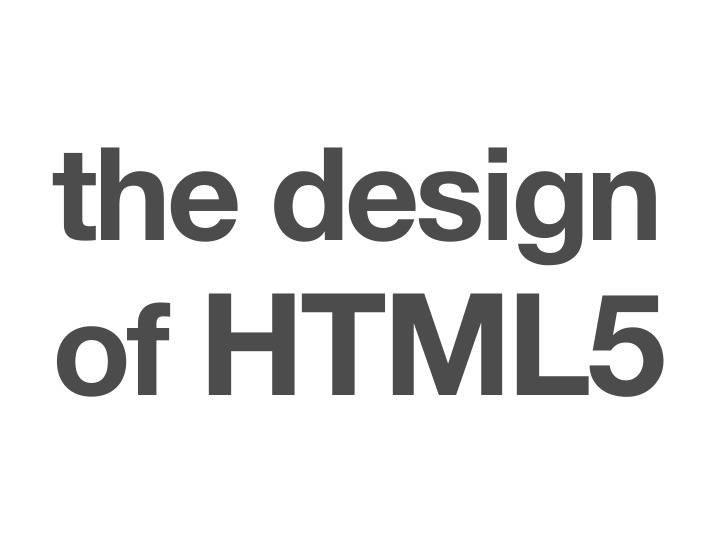



the design of HTML5
the design of HTML5
the design of HTML5
design principles
We hold these Truths to be self-evident, that all Men are created equal, that they are endowed by their Creator with certain unalienable Rights, that among these are Life, Liberty and the pursuit of Happiness. —e Declaration Of Independence, 1776-07-04
From each according to his ability, to each according to his need. —Karl Marx, 1875
Do unto others as you would have them do unto you. —Jesus of Nazareth, ~30AD
Four legs good, two legs bad. —George Orwell, Animal Farm
A robot may not injure a human being or, through inaction, allow a human being to come to harm. A robot must obey any orders given to it by human beings, except where such orders would conflict with the First Law. A robot must protect its own existence as long as such protection does not conflict with the First or Second Law. —Isaac Asimov, I, Robot
Principles such as simplicity and modularity are the stuff of soware engineering; decentralisation and tolerance are the life and breath of Internet. —Tim Berners-Lee, Principles of Design
HTML 2.0 1995 HTML 3.2 1997 HTML 4.0 1997 HTML 4.01 1999
XHTML 1.0 2000 XHTML 1.1 2001 XHTML 2
Be conservative in what you send; be liberal in what you accept. —Jon Postel, e Robustness Principle
WHATWG 2004 W3C 2007 HTML5
the design of HTML5
is document describes the set of guiding principles used by the HTML Working Group for the development of HTML5. e principles offer guidance for the design of HTML in the areas of compatibility , utility and interoperability . —HTML Design Principles w3.org/TR/html-design-principles
avoid needless complexity Simple solutions are preferred to complex ones, when possible.
HTML 4.01 <!DOCTYPE html PUBLIC "-//W3C//DTD HTML 4.01//EN" "http://www.w3.org/TR/html4/strict.dtd"> XHTML 1.0 <!DOCTYPE html PUBLIC "-//W3C//DTD XHTML 1.0 Strict//EN" "http://www.w3.org/TR/xhtml1/DTD/xhtml1-strict.dtd"> HTML5 <!DOCTYPE html>
HTML 4.01 <meta http-equiv="Content-Type" content="text/html; charset=utf-8"> XHTML 1.0 <?xml version="1.0" encoding="UTF-8"?> <meta http-equiv="Content-Type" content="text/html; charset=utf-8" /> HTML5 <meta charset="utf-8">
<link rel="stylesheet" type="text/css" href="file.css"> <script type="text/javascript"> </script> HTML5
support existing content Existing content oen relies upon expected user agent processing and behaviour to function as intended.
<img src="foo" alt="bar" /> <p class="foo">Hello world</p> <img src="foo" alt="bar"> <p class="foo">Hello world <IMG SRC="foo" ALT="bar"> <P CLASS="foo">Hello world</P> <img src=foo alt=bar> <p class=foo>Hello world</p>
Be conservative in what you send; be liberal in what you accept. —Jon Postel, e Robustness Principle
solve real problems Abstract architectures that don’t address an existing need are less favoured than pragmatic solutions to problems that web content faces today.
(X)HTML <h2><a href="/path/to/resource">Headline text</a></h2> <p><a href="/path/to/resource">Paragraph text.</a></p> HTML5 <a href="/path/to/resource"> <h2>Headline text</h2> <p>Paragraph text.</p> </a>
pave the cowpaths
section header article footer aside details nav figure
<body> <div id="header">...</div> <div id="navigation">...</div> <div id="main">...</div> <div id="sidebar">...</div> <div id="footer">...</div> </body>
<body> <header>...</header> <nav>...</nav> <div id="main">...</div> <aside>...</aside> <footer>...</footer> </body>
section header article footer aside details nav figure
<div class="item"> <h2>...</h2> <div class="meta">...</div> <div class="content"> ... </div> <div class="links">...</div> </div>
<section class="item"> <header><h1>...</h1></header> <footer class="meta">...</footer> <div class="content"> ... </div> <nav class="links">...</nav> </section>
<section class="item"> <header><h1>...</h1></header> <footer class="meta">...</footer> <div class="content"> ... </div> <nav class="links">...</nav> </section>
I would in fact prefer, instead of <H1>, <H2> etc for headings to have a nestable <SECTION>.. </SECTION> element, and a generic <H>..</H> which at any level within the sections would produce the required level of heading. —Tim Berners-Lee, 1991
degrade gracefully HTML 5 document conformance requirements should be designed so that Web content can degrade gracefully in older or less capable user agents, even when making use of new elements, attributes, APIs and content models.
input type="number" input type="search" input type="range" input type="email" input type="date" input type="url"
input type="number"
input type="search"
input type="search" placeholder="e.g. salad or fish"
HTML5 Flash video object
<video src="movie.mp4"> <!-- fallback content --> </video>
<video src="movie.mp4"> <object data="movie.swf"> <!-- fallback content --> </object> </video>
<video src="movie.mp4"> <object data="movie.swf"> <a href="movie.mp4">download</a> </object> </video>
<video> <source src="movie.mp4"> <source src="movie.ogv"> <object data="movie.swf"> <a href="movie.mp4">download</a> </object> </video>
<video> 1 <source src="movie.mp4"> 2 <source src="movie.ogv"> <object data="movie.swf"> 3 <a href="movie.mp4">download</a> 4 </object> </video>
e value of a network is proportional to the square of the number of connected users of the system (n2). —Robert Metcalfe
priority of constituencies In case of conflict, consider users over authors over implementors over specifiers over theoretical purity .
Soware, like all technologies, is inherently political. Code inevitably reflects the choices, biases and desires of its creators. —Jamais Cascio
1. Make the most equent tasks easy and less equent tasks achievable. 2. Design for th e 80%. 3. Privilege the Content Creator. 4. Make the default settings smart. —Mark Boulton, Leisa Reichelt, d7ux.org
Design for humans first, machines second. —Microformats.org, e microformats principles
e effectiveness of the Internet as a public resource depends upon interoperability (protocols, data formats, content), innoation and decentralised participation worldwide. Transparent community-based processes promote participation, accountability, and trust. —e Mozilla Foundation, e Mozilla Manifesto
Rough consensus and running code. —e Tao of IETF
@adactio adactio.com books.alistapart.com
Recommend
More recommend